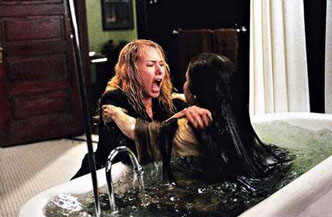Hollywood Psych
By Sean Collier
July 23, 2009
BoxOfficeProphets.com

This weekend's release of Orphan, yet another unnecessary chapter in the long children-are-menacing horror trend, serves to illustrate a pet theory of mine about modern American horror. As far as mainstream scare flicks go, the last 30 years have been dominated by the lingering influence of three films, each changing the horror game slightly and spawning constant imitation until the next big thing hits. (This, of course, could be said about a great many genres, but I think it's more blatant here.)
The godfather, of course, is Halloween. The rules of horror that have been spoofed and redone and respoofed and remade a thousand times were all set by Jamie Lee Curtis and company. For the better part of two decades, horror sought to build big, mythology-heavy franchises, made on the cheap, with each new chapter adding a plot point or two while systematically leveling a suburb's worth of cheerleaders and/or camp counselors.
This model, of course, grew quite stale by the '90s. It was left to Wes Craven, one of the originators, to reinvigorate it. Scream is the spiritual successor to Halloween, and operates in much the same way; while it deconstructs the slasher genre, it's a dutiful entry into the same. However, a subtle difference would lead to a long line of Scream imitators. Halloween, Friday the 13th and their ilk were horror movies that happened to concern teenagers; Scream was a teen movie that happened to be scary. (It's no coincidence that Dawson's Creek creator Kevin Williamson penned the first two Scream films.) This concept would prove to be a golden goose for most of the '90s and the beginning of the 21st century, as anything with a crew of twentysomething high schoolers and a vaguely menacing villain was guaranteed to be at least a modest hit.
In 2002, the playbook was thrown out. The Ring, a remake of a notorious Japanese thriller and a strong sleeper hit, introduced the elements of horror that have dominated multiplexes through the decade: creepy children, vague, unnamed threats, the influence of foreign chillers, and (most terrifyingly of all) PG-13 ratings. While legitimately well done and initially scary, The Ring was just too ripe for imitation, and horror has choked under a glut of so-so imitations ever since.
The specific trouble here is that The Ring's merits can't be easily duplicated. After Halloween, it was easy to set up a boogeyman that could stalk across eight films; after Scream, it was easy to throw together a likable bunch of hormonal upperclassmen and have them run through suburbia shrieking for a couple of days. It's much harder, however, to keep a concept like vague evil or ghostly curses fresh. The dreadful attempts could fill up the midnight slot on AMC for months: The Grudge series, Dark Water, An American Haunting, The Amityville Horror, The Exorcism of Emily Rose...
What is desperately needed, now seven years removed from Gore Verbinski's unlikely hit, is the next big thing. Eli Roth and the cottage industry that is Saw tried desperately to make torture-porn (I still prefer the term "gorno") that development, but this proved too extreme to have much mainstream impact. Such a film can usually not be predicted, as Halloween, Scream and The Ring are all simply well-made horror films that struck the right note at the right time; if studios could predict when that would happen, box office prognostication wouldn't be particularly necessary.
I should clarify that the best horror films fall outside of these parameters; without fail, the true gems of the genre operate independently of greater trends. However, as with any genre, breathing fresh air into stale trends always makes for at least a couple improved years at the cinema. Studios would be wise to start throwing out whatever chillers they've been kicking around, in hopes of unwittingly discovering the next genre-changer.
Until then, would the bluish children in the attic please stop their clicking noises. It's not doing anything for me, and I'm trying to sleep down here.